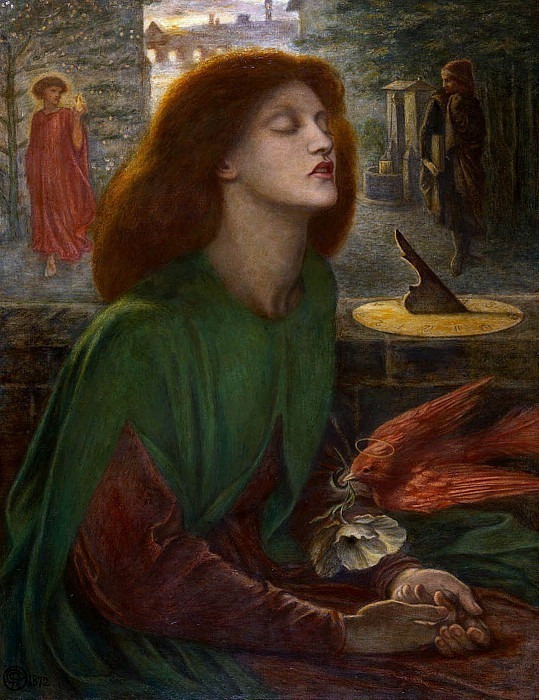Beata Beatrix Dante Gabriel Rossetti (1828-1882)
Dante Gabriel Rossetti – Beata Beatrix
Edit attribution
Download full size: 1622×2107 px (0,3 Mb)
Painter: Dante Gabriel Rossetti
Location: Art Institute, Chicago.
Dante Rossetti, like his famous writing idol, had a lover named Beatrice. This similarity was fatal. The girl, as well as the poet’s passions, was not destined for a long and happy life. She died at a very early age from ingesting laudanum. The only significant and significant difference was the fact that Rossetti was married to his beloved. The terrible tragedy happened to Beatrice back in 1862.
Description of Dante Rossetti’s painting Beatrice the Blessed
Dante Rossetti, like his famous writing idol, had a lover named Beatrice. This similarity was fatal. The girl, as well as the poet’s passions, was not destined for a long and happy life. She died at a very early age from ingesting laudanum. The only significant and significant difference was the fact that Rossetti was married to his beloved. The terrible tragedy happened to Beatrice back in 1862. The artist was very hard experiencing her death. He kept repeating the invisible connection with Dante the poet and his passion. It drove everyone crazy.
It is worth noting that during his wife’s lifetime he often depicted her in paintings. It could have been completely different images, but after her passing it all came to a screeching halt. This painting became a point of reference in a new phase of Dante Rastretti’s style and manner of painting. He called the painting Beatrice the Blessed. It is worth noting that for all his point about his beloved, the artist did not intend to portray death as something bad, shameful or abominable. On the contrary, for him the end of earthly life is a kind of ecstasy. Notice the girl’s face. It clearly doesn’t look clouded or full of misery. That’s right, because death relieves all suffering. It is a kind of spiritual transformation, reincarnation of man. This is what his beloved had also come to.
Rastretti depicted the eyes of Beatrice closed, respecting the rules of the ancient canons of the image of the dead. What can display the eyes of the dead, if he already sees quite differently, aimed at the otherworldly. The appearance of his wife is interesting: her hair is surrounded by an incredible light - it is a halo over her head, and an unknown bird blows over her large and beautiful poppy flower - a symbol of eternal sleep and finding solace. If we look at the background of the painting, we see that the artist depicted the sunset: the sunset of the day, the sunset of life... Isn’t it symbolic?
Кому понравилось
Пожалуйста, подождите
На эту операцию может потребоваться несколько секунд.
Информация появится в новом окне,
если открытие новых окон не запрещено в настройках вашего браузера.
You need to login
Для работы с коллекциями – пожалуйста, войдите в аккаунт (open in new window).











![Dante Gabriel Rossetti - Portrait of Queen Isabel [Attributed]](http://cdn.gallerix.asia/j/V/129426674/3933.webp)








You cannot comment Why?
In the background, a garden setting unfolds with a sundial prominently placed on a stone ledge. To the left, a figure in a red robe, possibly representing Cupid or a messenger of love, holds a flickering flame. To the right, a cloaked and hooded figure, possibly representing Dante, stands in contemplation, looking towards a building with illuminated windows in the distance, suggesting the setting of Florence. The overall atmosphere is one of spiritual introspection and a sense of divine connection.
The painting is rich in symbolism. The woman is widely understood to be Beatrice Portinari, the muse and idealized love of the poet Dante Alighieri. The title, Beata Beatrix, translates to Blessed Beatrice, referencing her beatification and ascension to heaven following her death. The closed eyes and serene expression suggest Beatrice is in a state of spiritual rapture, experiencing a mystical vision or divine connection.
The white poppy is often associated with sleep, peace, and death, but here it also symbolizes oblivion and the transition from earthly love to divine love. The red bird, a symbol of the soul and divine messenger, offering the poppy, signifies the transmission of this spiritual essence to Beatrice. The sundial in the foreground represents the passage of time and the earthly realm, contrasting with Beatrices transcendence. Dantes presence in the background highlights the enduring love and inspiration Beatrice provided him throughout his life and work, particularly in his epic poem The Divine Comedy. The overall subtext explores themes of love, loss, spiritual transcendence, and the idealized nature of love that endures beyond death.